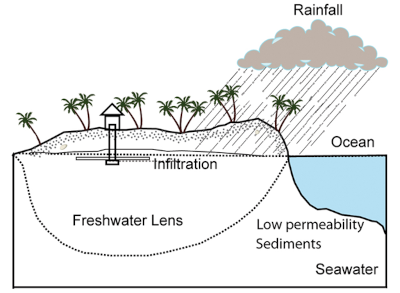The climate change-induced sea-level rise is posing significant challenges to coastal regions and small islands due to flooding waters and the inundation of low-lying land areas.
 Schematic illustration of a freshwater lens on an island. Image Credit: Wikimedia Commons.
Schematic illustration of a freshwater lens on an island. Image Credit: Wikimedia Commons.
Climate change has become a more critical issue recently, especially for island countries and island provinces like the Bahamas. They are not only facing a water shortage problem because of the limitations of the islands, but also they are facing a coastal inundation problem due to sea level rise caused by climate change.
Yipeng Zhang, Postdoctoral Associate, University of Texas at El Paso
The study was presented by Zhang at the Geological Society of America’s Connects 2021 annual meeting held in Portland, Oregon. It aims to quantify the impact on freshwater resources on small tropical islands due to sea-level rise.
What makes the news quite a bit, rightfully so, when we think about sea-level rise and islands is inundation and loss of land, especially for low-lying islands, but our focus is water resources.
Alex Mayer, Principal Investigator and Professor of Civil Engineering, University of Texas at El Paso
“In island aquifers, freshwater is usually found on a lens sitting on top of seawater, due to density differences. That [freshwater] lens can be a very precious and valuable resource especially because many of these islands don’t have access to sufficient surface water resources, so they’re maybe completely dependent on the groundwater,” added Mayer.
It is well known that the freshwater declines with an increase in sea level and the coastline get inundated, thus posing risk to freshwater resources. The research team led by Zhang and Mayer is focusing on the impacts on lakes forming and expanding on small islands.
Flooding and inundation are expected to increase with the rise in sea level. These effects are likely to take place in the central interior of islands, so lakes or wetlands can expand laterally, and new lakes can form.
The lakes are in hydrologic connection to the groundwater. Evaporation rates from the lake are much greater than the evaporation rates from the land surface, and so the lakes can act as a pump, essentially, in drawing water from below. And that can result in saltwater coming up all the way to the surface.
Alex Mayer, Principal Investigator and Professor of Civil Engineering, University of Texas at El Paso
This “pumping” effect is capable of bringing saltwater to the surface, which can divide and compromise the lens of freshwater, thus lowering the volume of existing freshwater used for drinking and other needs.
Zhang and Mayer tried to study the impacts of expanding lakes on freshwater resources using the several modeled scenarios pertaining to the 30-year climate record from San Salvador in the Bahamas and varying rates of sea-level rise subjected to seasonal climate differences.
Zhang focuses his study specifically on the effect of mixing that happens at the interface of the freshwater lens and saltwater below, as the mixing can lead to contamination of the freshwater. With the increase in sea level and the formation and expansion of lakes, the mixing zones eventually increase, leading to a decrease in available freshwater.
The difference in seasonal climate variation between wet and dry phases also contributes to the mixing, as the lens tends to grow in the wet season and retract in the dry season, thus moving back and forth in a cyclical motion.
The development of sustainable groundwater strategies for the ocean requires a clear knowledge of the impact of sea-level rise and lake formation on freshwater lens resources. In the case of islands that depend on this groundwater as their key source of potable water, desalination may become an inevitable part of their future.
Mayer concluded, “I would hope there’s some kind of climate justice involved, too, to help island nations overcome the problems of sea-level rise. In my mind, the island nations did not cause the problem, it’s the responsibility of the industrialized nations.”